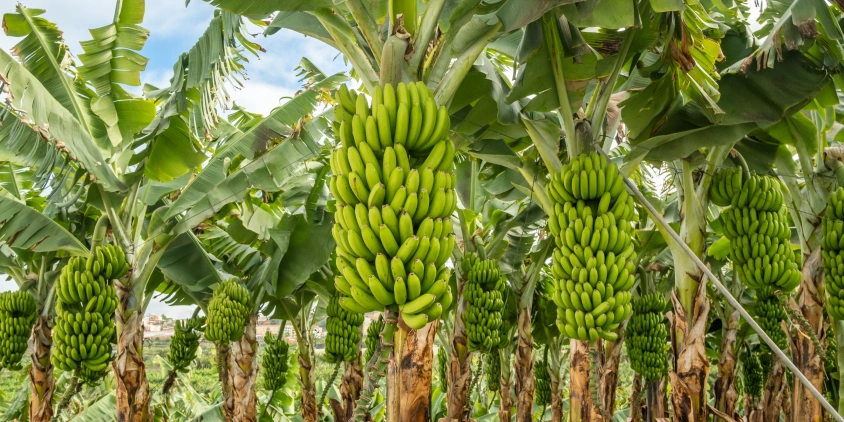
Growing Bananas: How To Plant And Care For Plantation
Bananas are one of the world’s most popular fruits, successfully cultivated in tropical growing regions and bearing fruit all year. Although growing bananas commercially is not too troublesome, crop producers must be extra cautious about diseases that threaten the most popular crop varieties, often grown in monoculture. Today’s growers actively use modern remote sensing technologies to prevent and control diseases in their early stages, thereby saving banana plantations from significant losses. Read our article on the banana growing process to learn the ways of increasing yields, improving fruit quality, and streamlining processes for maximum profit.
Banana Plant Types And Varieties
A banana plant is a large, tree-like flowering herb in the Musaceae family. In banana farming, two crop types are distinguished based on their respective uses:
- Dessert fruits, sweet and consumed raw, are primarily cultivated in Africa, Latin America, and the Caribbean for being marketed worldwide. Popular dessert varieties include Cavendish, Blue Java, and Lady Finger. Although the Cavendish variety is now the market leader worldwide, it is in danger of extinction due to Fusarium wilt, a lethal fungal crop disease.
- Cooking fruits with a starchy texture are widely cultivated in the Asia-Pacific growing region for local consumption. Cuban red and plantain are two of the most common cooking varieties.
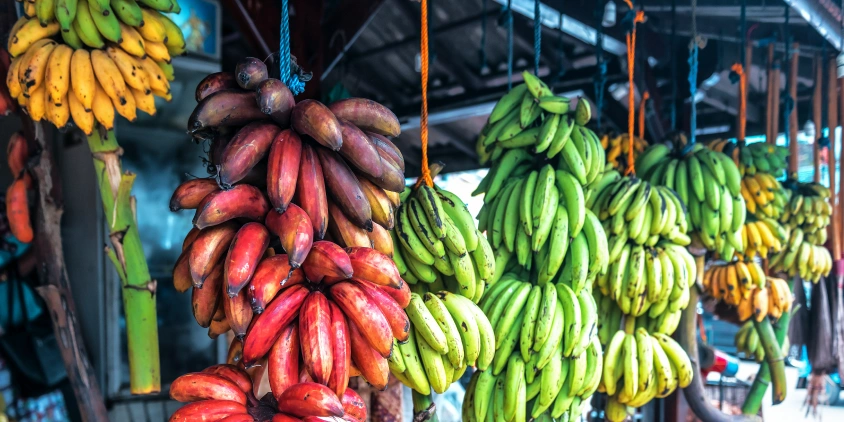
Plantain, a staple diet in many tropical countries, is just one variety of cooking banana plants.
Requirements For Banana Growing Conditions
The ideal growing conditions for bananas are warm and humid. As long as the plants receive enough water and nutrients, they can grow in hillside regions up to a height of 1200 meters.
How Much Warmth And Light Does A Banana Plant Need?
Consistently warm temperatures in the range of 79°F (26°C) and 86°F (30°C) are preferred for growing bananas. Colder than 59°F (15°C) can stunt plant and fruit growth. During the summer, strong, hot winds can rip the leaves and dehydrate them. For growing abundant crops, a minimum of 8 hours of sunlight daily is needed.
Bananas thrive in tropical growing regions with average temperatures of 80°F (27°C). Farmers grow most of the marketed fruits within a 30-degree range north and south of the equator.
Find out if your growing region is suitable for banana plantations by using Historical weather in EOSDA Crop Monitoring. Later, throughout the growing period, rely on the Weather forecasts, for example, to prevent heat stress through timely watering and thermal shading.

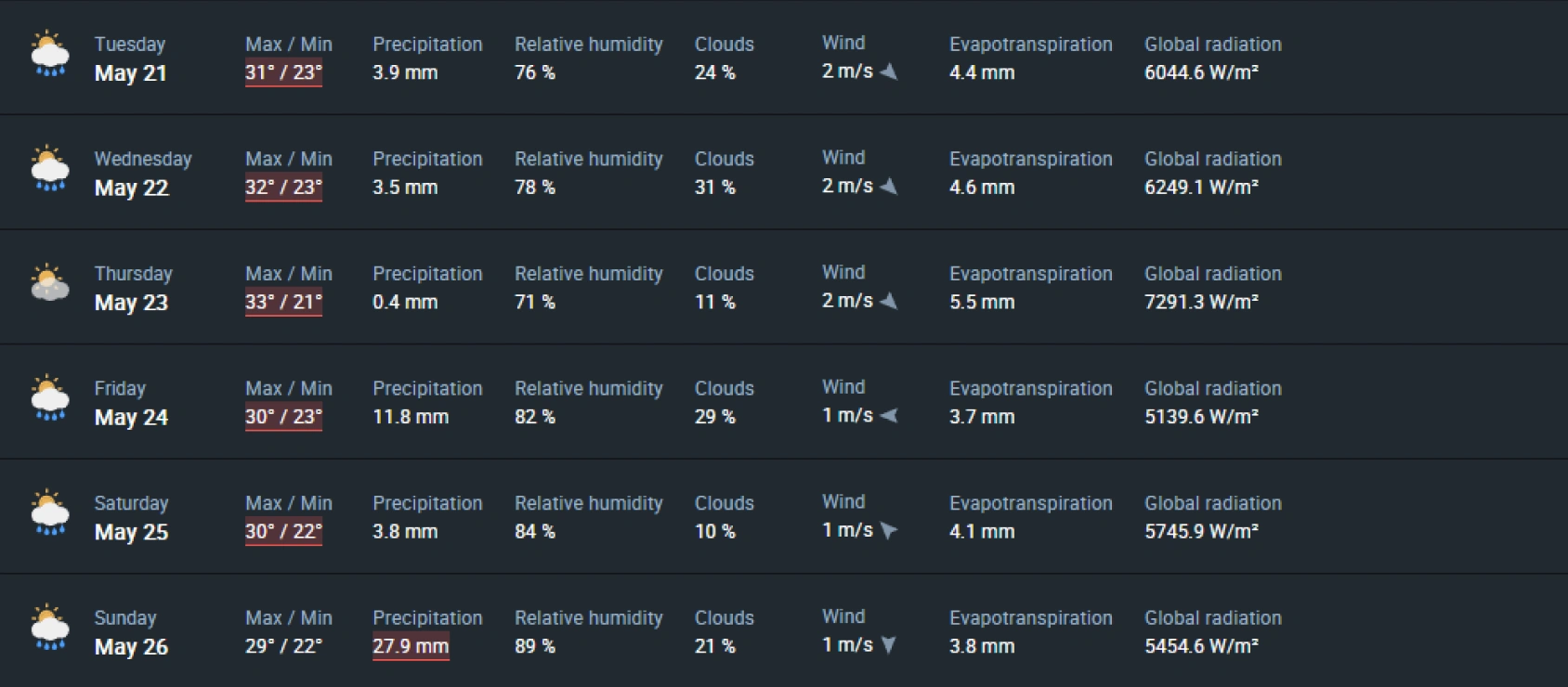
How Much Water Do Growing Plants Need?
The growing crop requires about 4–10 inches (100–250 mm) of water monthly. However, waterlogging can harm the roots, so good drainage is crucial. Look for a growing site with a relative humidity of 70 to 80%. Such a high humidity level will help maintain the optimal plant’s temperature and prevent excessive water loss through evapotranspiration.
To keep an eye on soil moisture levels in your banana plantations, try using precision agriculture tools. You can access root-zone and surface soil moisture data, both current and historical, through the EOSDA Crop Monitoring platform. This ensures the precise timing and amount of watering required for your growing plants.
What Is The Best Soil For Banana Plants?
The ideal soil for growing the crop is rich in organic matter and deep —1.6–3.3 feet (0.5–1 m), retains moisture well, and has good drainage. Being a heavy feeder, the plant places a premium on fertility and nutrient availability. The optimal banana soil pH range is between 6.0 and 7.5, since soils that are too acidic or too alkaline can reduce the availability of nutrients for the growing plant.
On steep slopes, prone to soil erosion, where the crop is often cultivated, farmers typically practice contour growing. The plants grow best in riverine and volcanic soils. Clay soils can also work if they drain well. As for clay soils, their poor water and nutrient retention capacity make them problematic for growing the crop. This is where organic matter amendments come in handy.
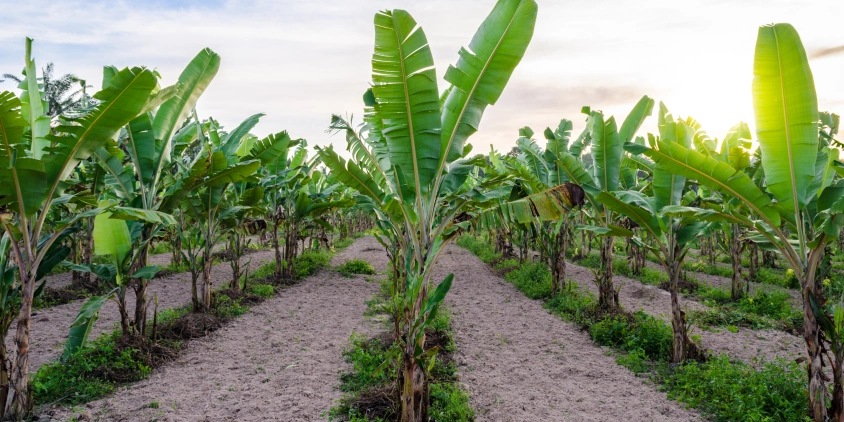
How To Plant Bananas?
There are several types of banana planting material, ranging from suckers, the most popular in commercial farming, to seeds, the least popular. The planting method and other growing aspects may vary depending on the selected planting material.
Banana Planting Material
Commercial farmers typically use the first two of the four materials available for banana planting. Let’s weigh every option:
- Suckers, aka pups, are offshoots growing from a plant’s base. Most commercial plantations prefer suckers with an extensive rhizome system and rapidly growing conical buds. While suckers share the same genes as the parent plant and yield much faster than seeds, they may harbor diseases or nematodes and produce an uneven harvest.
- A tissue culture is a type of laboratory-grown plantlet. Compared to suckers, tissue cultures are more expensive, but they are free of diseases (which is crucial under recent the Fusarium wilt threat) and yield a more uniform crop.
- A rhizome is a modified plant stem that grows underground. Although it is possible to grow a plant from a rhizome, it is not common for commercial purposes.
- Seeds of bananas are tiny and often sterile. As a result, growing the crop from seeds is the least feasible.
To save money, approximately 70% of commercial farmers use suckers for planting bananas, while almost all of the remaining farmers use tissue cultures, which facilitate future crop management.
Banana Planting Distance And Depth
Banana plant spacing is mainly determined by crop variety, growing conditions, and management practices. Plant spacing typically ranges from 6.5 by 6.5 feet (2 by 2 meters) to 16.4 by 16.4 (5 by 5 meters). This translates to a density of 160 to 1010 plants per acre (400 to 2500 plants per ha). Another option, aimed at boosting crop yields, is to plant at a high density, starting at 1620 plants per acre (4000 plants per ha). However, this method typically necessitates adjustments of agronomic procedures, is more stressful on the soil, depletes nutrients, and increases the risk of crop diseases .
It is standard practice to plant suckers with the growing tip above ground level and the pseudostem’s base slightly below. Suitable banana planting depths range from 2 to 4 inches (5 to 10 cm). To promote yields on suboptimal fields, dig deeper planting holes and fill them with crop leftovers, manure, and soil.
EOSDA Crop Monitoring
Performing fields analytics based on relevant satellite data to ensure effective decision-making!
Banana Plant Care And Maintenance
These plants thrive when provided with ample moisture and nutrients. Furthermore, plants must be regularly pruned and supported throughout fruiting to promote their healthy development. Last but not least is the control of pests and diseases, such as Fusarium wilt (Panama disease), which pose a major threat to banana plant cultivation worldwide.
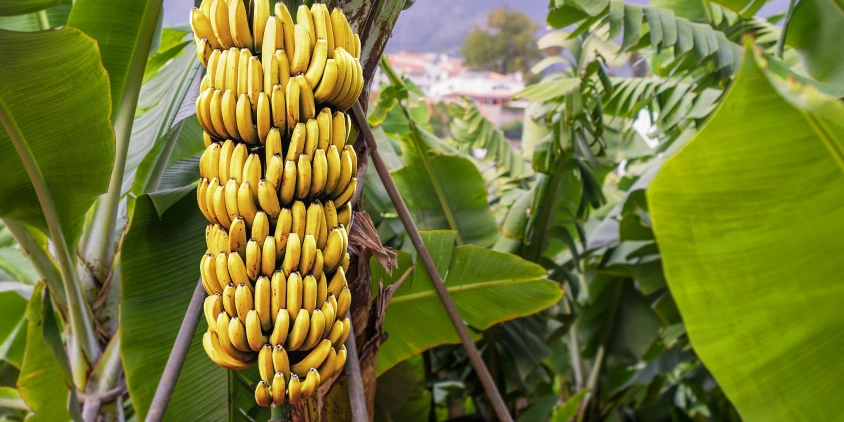
Banana Plant Pruning
Regular pruning helps control the plant’s structure, which in turn makes maintenance easier, encourages robust crop growth, and maximizes fruit yield. Let’s see how to prune a banana plant for certain purposes:
- get rid of any infected or dead leaves to avoid the spread of disease and enhance photosynthesis;
- cut the lower leaves to let sunlight reach the growing banana fruits;
- remove all except one vigorous sucker to decrease competition for resources with the main false stem;
- perform denavelling, i.e., remove the male bud after the female flower stage, to promote fruit development;
- after flowering, pluck any underdeveloped hands (clusters of fruits within a bunch) and perhaps the ones directly above them to encourage the growth of heavier fruits in the bunch;
- once the plant is harvested, remove the spent pseudostem and use it as mulch around the plant’s base. This will help retain moisture and add nutrients to the soil for the next growing crop.
Supporting The Plant Through Propping
Despite its tree-like appearance, the banana plant actually has a rather unstable herbaceous false stem that requires support while growing to keep it from toppling over. When fruit bunches overwhelm the plants, support becomes critical. Common forms of support include propping, staking, or wire systems. All of the support materials used in banana plantations must be sturdy and flexible enough to meet the needs of the plants as they grow, as well as safe for the workers to handle.
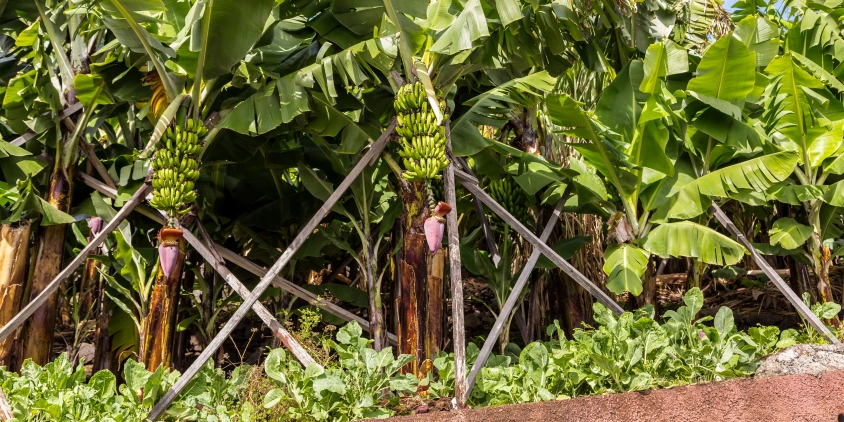
Fertilizer Application To Banana Plants
To grow and produce well, the crop needs a balanced fertilizer, like one with an 8-10-8 NPK rate. Nitrogen is essential for early growth, and potassium promotes disease resistance and fruit development. Compost, well-rotted manure, or bone meal are suitable organic alternatives to synthetic fertilizers.
How often to fertilize banana plants? While the plant is actively growing, fertilize it every two weeks to two months, depending on the fertilizer and growing conditions. A monthly application of 0.25 to 0.5 pounds (0.11 to 0.23 kg) of NPK fertilizer may be necessary for young plants due to their rapid growth rate. Fertilizing during the fall and winter is unnecessary.Fertilizing is just one of many operations that can be easily tracked with EOSDA Crop Monitoring’s Field activity log. By simply adding your planned and completed tasks to the interactive calendar and editing them as needed, you can manage activities across multiple banana plantations in a single, user-friendly environment.

Banana Plant Watering
Commercial farmers generally irrigate the crop through overhead sprinkler systems that deliver small amounts of water at frequent intervals . But since the majority of plant roots are located in the top 20 inches (50 cm) of soil, it is crucial to keep water available in this layer. Drip irrigation of bananas is thus the ideal method for supporting growing crops. Mulching can also help improve water management on your plantations.
It’s important to consider that in growing regions with high evaporation rates, low precipitation, and even a trace amount of salt in the water, drip irrigation can cause salts to build up at the soil-water interface. In these situations, leaching may be required to avoid damage to growing banana plants, which are extremely sensitive to salt.
With satellite crop monitoring, keeping tabs on your plants’ water needs is a breeze. When plants show an abnormally high or low NDMI index reading — a trustworthy indication of crop water stress — it could mean, for instance, that the soil is too dry or that the growing plants aren’t absorbing enough water. By early identification of these outliers, you have ample time to figure out the cause and solution.

Banana Disease And Pest Management
Growing bananas are exposed to many pests and diseases, which cause huge economic losses and can even make some varieties extinct. Banana farmers use many pest and disease control techniques, one of the most basic being covering the bunches in specialized plastic bags, to shield their fruit from pests and diseases. There are other methods of combating threats, both general and specific, which we will consider further.
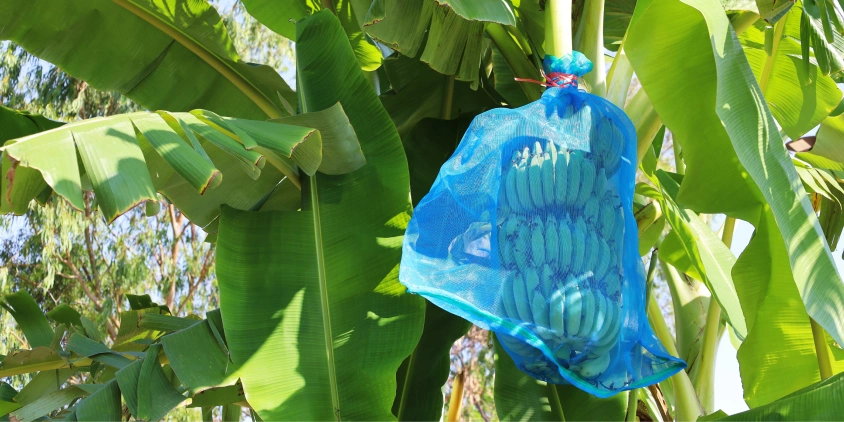
| Disease | Symptoms | Management |
|---|---|---|
| Panama disease (Fusarium wilt) |
|
|
| Yellow sigatoka (Mycospharella musicola) |
|
|
| Bunchy top |
|
|
| Mosaic (infectious chlorosis) |
|
|
| Banana bract virus |
|
|
| Anthracnose (Gloeosporium musarum) |
|
|
| Erwinia rot |
|
|
Combating banana diseases can be greatly enhanced by insights into disease dynamics gained through remote plantation monitoring and the use of satellite indices. For more information, check out our case study on Dole Asia’s use of agriculture technologies to proactively address crop diseases.
The most harmful pests to the crop include the banana weevil, cosmopolites sordidus, and nematodes . If left unchecked, they can cause significant yield damage. Thankfully, with our Scouting feature, you can quickly target specific areas of your banana plantation where pests are most likely to grow and spread. According to the reports you receive, you can immediately plan treatment for those areas.
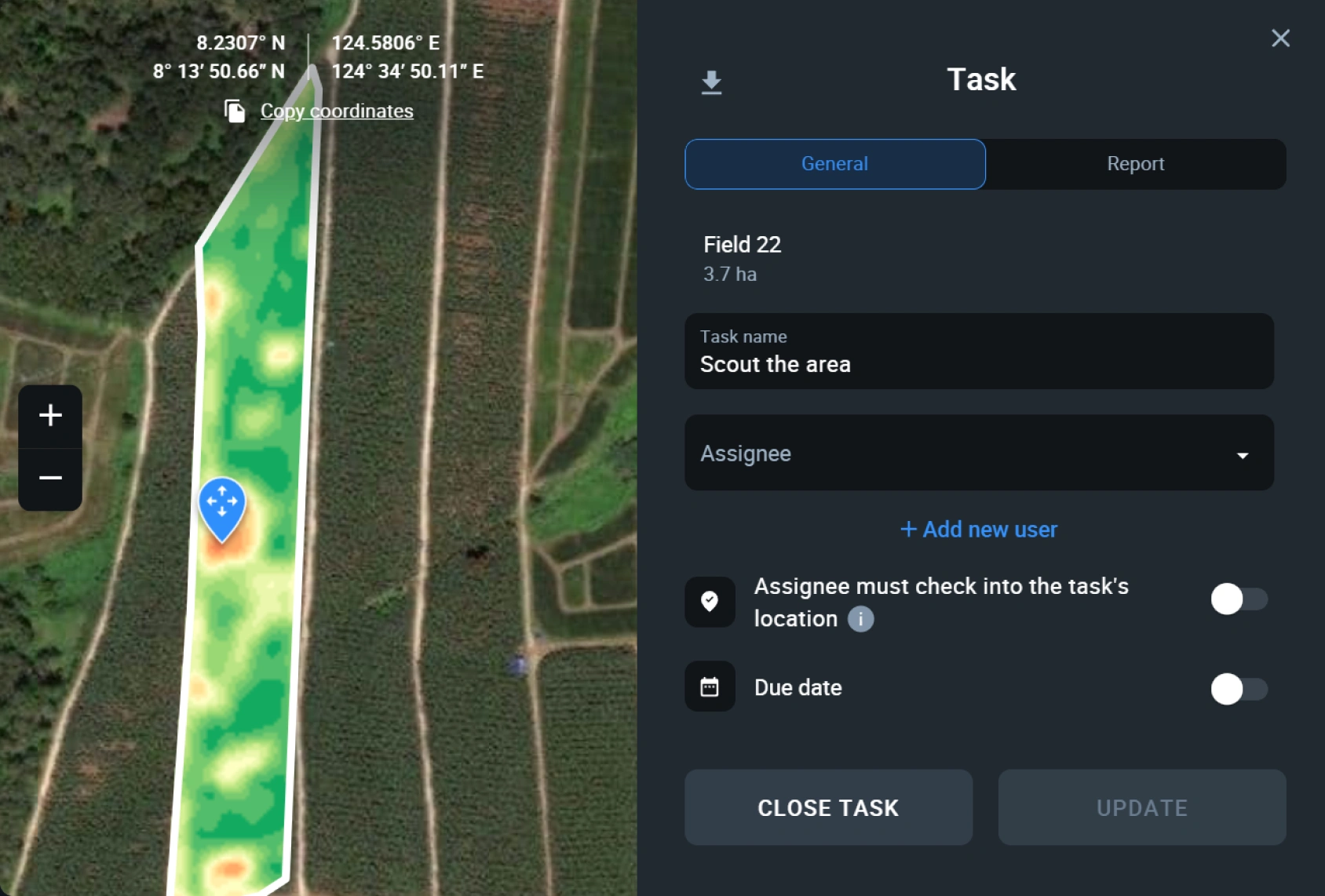
Access to precise yield predictions can help farmers and insurance companies better manage the various risks associated with growing bananas. Our tailor-made Crop yield prediction solution to forecast yields up to three months in advance and adjust their farm activities accordingly for optimal harvests.
How Long Do Bananas Take To Grow?
The banana plants go through three main growth stages: vegetative growth (around 6 months), flowering (around 3 months), and fruit development (around 3 months). So, the time between planting and harvesting typically ranges from nine to twelve months, depending on the variety’s maturation period and local growing conditions. Unlike apples and other fruits with a distinct growing season, bananas are always in season.

When And How To Harvest Bananas
Growers harvest bananas before they are fully ripe. Dwarf varieties take about 11–14 months from planting to harvest, while taller varieties take about 14–16 months. The typical shoot-to-harvest period for a bunch is 3–4 months. Indications that it is time to harvest include the top leaves drying out, a change in the fruit’s color from dark green to light, and the blossom end falling off with just a touch. The fruit becomes plump and completely filled in.
As a rule, a two-person crew manually gathers fruits. As one person cuts the bunch, the other takes it and carries it away. Harvesting dwarf banana varieties, plantation workers cut the bunch stalk approximately 12–14 inches (30–35 cm) above the top plant hand. For taller varieties, workers first partially cut the plant’s false stem to bring the bunch within reach and then cut the bunch off.
To ensure safe transportation to a packing shed, bunches are carefully stacked on a padded trailer. Then, bunches are dehanded, and fruits are washed and packed for shipping to markets domestically and abroad.
About the author:
Vasyl Cherlinka is a Doctor of Biosciences specializing in pedology (soil science), with 30 years of experience in the field. He attended the engineering college in Ukraine and received his degree in agrochemistry, agronomy and soil science in the Chernivtsi National University. Since 2018, Dr. Cherlinka has been advising EOSDA on problems in soil science, agronomy, and agrochemistry.
Recent articles

Analyze 2025 & Plan Your Best Year Yet: LandViewer Christmas Offer
It’s the most wonderful time of the year! The Christmas holidays are here, and so is your chance to analyze 2025 and plan a prosperous 2026 with more affordable Pro plans in LandViewer.

EOSDA Models Climate Change Impact On Sugarcane Yields
EOSDA modeled future temperature, rainfall, and other climate impacts on Veracruz sugarcane. The results help growers plan long-term adaptation strategies, including timing, varieties, and irrigation.

EOSDA LandViewer Black Friday Sale: Exclusive Offers & Giveaway
This Black Friday, LandViewer offers new users the chance to save on monthly plans, get extra months with yearly subscriptions, and participate in a free annual plan giveaway.